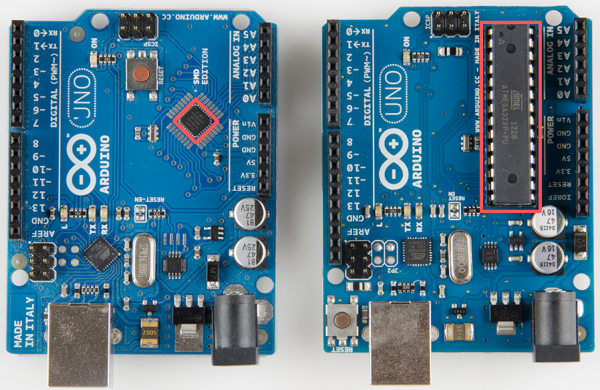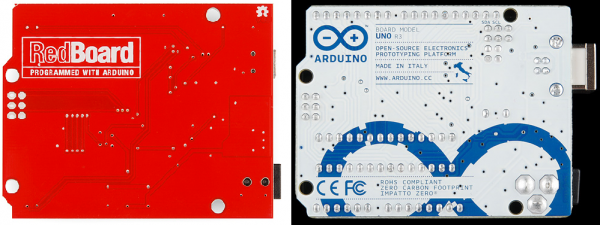RedBoard vs. Uno
SMD vs PTH
The Arduino Uno comes in two forms: surface mount (SMD) and through-hole (PTH). Both versions are very similar, the only significant difference comes from what package the ATmega328 processor comes in. SMD components are generally easier to mass assemble (though harder to manually assemble), so the SMD version of the Uno is either cheaper, more readily available, or both.
The RedBoard is only offered in one form: surface mount. The design actually takes the SMD choice even further by making every component SMD (the Arduino UNO SMD still has PTH connectors, for example), but the main focus of the SMD vs. PTH debate centers around the package of the microcontroller (as highlighted in the image above).
SMD Pros and Cons
Pros: No Snags, Lower Cost
The absence of PTH components on the RedBoard means a nice, smooth surface on the bottom of the board -- there's no danger of being pricked by pointy solder joints.
On top of that, eliminating exposed joints on the bottom of the board also protects the components from accidental shorts. As any hobbyist with a messy desk could attest, stray wire clippings and other metals strewn across workbenches are a common source of accidental short circuits. Standoffs or Arduino holders will help prevent against this if you're using an Arduino board.
Con: Hard to Swap µCs
Microcontrollers (µCs) -- in this case the ATmega328 -- are usually the most expensive component in a design. A µC failure* is hard to overcome, and it usually requires either replacing the component or just recycling the board.
The nice thing about the PTH Arduino is the ATmega328 is socketed, so if it blows up* replacing the chip is as easy as prying it out and sticking in a new one.
The ability to easily remove the ATmega328 has other advantages as well. For example, if you're looking to build a project using the IC, you can prototype in the development board and eventually transfer the microcontroller out of the Uno to a custom board.
*: Microcontroller failure on all of these boards is a big "if". The ATmega328 is a very resilient microcontroller. You really have to try to fry the IC, or even just a single I/O pin on it. A failure in the power circuitry (voltage regulators specifically) is much more likely.

